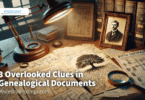If your ancestors aren’t showing up in the census, if there is a gap in the census years in which they appear, or you have run out of obvious sources for looking for them, don’t abandon that line of research just yet. There are plenty of alternative sources you can use to tease out more information about your ancestors. Here are some of the best alternative sources to use, how to use them, and where to find them.
1. City Directories
Even before there was the telephone, there were city directories. Back before the telephone, city directories listed a person’s address, and sometimes their profession and other people who were living in their house with them. New directories were usually put out every year for most cities, and even some small towns published them. These are a good source of information on your ancestors in between census years, and can sometimes even allow you to discover new family members who are not mentioned in any other sources (such as small children who did not live beyond young childhood, or elderly in-laws whose surname you did not previously know.
You can find searchable old city directories online on Ancestry.com for a membership fee. Some other sites, such as the US GenWeb project, may also have city directories to search for free. If you are in a town that has an archives building or a library with a genealogy department, you can often find old city directories there to look through by hand. City directories first started coming into use in the mid-19th century and go up to the present.
2. The Social Sections of Old Newspapers
Anything different that happened in town was considered news in the 1800s and early 1900s. Most newspapers had social sections to report on who was visiting who and from where, who was going on vacation, who was moving, who was a recent arrival in town as a new resident, and all kinds of other such mundane things. You can even find things like family reunions, wedding anniversaries, the details (including guest lists) of children’s birthday parties, and descriptions of social events that took place in town (even in private homes, including who attended). You can get all kinds of details on your ancestors’ personal lives from these news pieces.
Ancestry.com, GenealogyBank.com (both subscription sites), and the U.S. GenWeb project have extensive searchable collections of old newspapers from all across the country. They are well worth using to look for family history information.
3. Old Yearbooks
Old yearbooks are increasingly being published online, mostly on Ancestry.com but sometimes in other places. These will give you not only information on what your ancestors did in high school, but will often give you insights into what their classmates thought of them, and sometimes even a photo (or more than one, if your ancestor was in a club or group, or more than one).
When you think you have run out of places to look for family history information, don’t forget to look for alternative sources. There are plenty. These are just a few examples of the many hidden genealogical gems that are available for you to use to continue and even add to your ancestor search.
Related Books:
- The Official Guide to Ancestry.com
- Unofficial Guide to Ancestry.com: How to Find Your Family History on the No. 1 Genealogy Website






